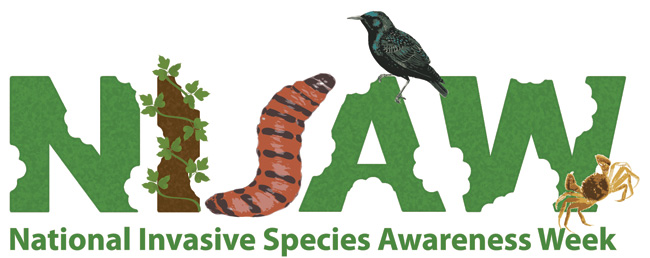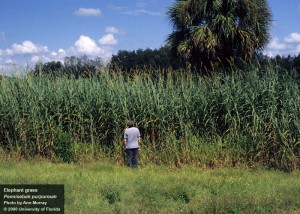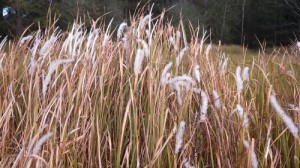
March 2nd: Cogongrass (Imperata cylindrica) & Napier Grass (Pennisetum purpureum):
Cogongrass: Cogongrass is one of the 10 worst weeds in the world. This grass is an aggressive grower and forms colonies causing loss of productive forest areas, severe degradation of habitat, and economic issues. Since its introduction in the 1900s, Cogongrass has spread to most of the counties in Florida. Reproduction occurs through seed production and the creeping rhizome system. This plant is prolific once established with the creation of a very dense rhizome system that retains water and releasing of allelopathic chemicals reducing competition from other plants. The main identifying characteristic is the off-center mid rib and its yellow green coloring.
Once this grass invades, it will quickly displace the native species and requires frequent and intensive controls. Early detection is best since a small infestation is easier and cheaper to treat. The larger infestations become more time intensive, expensive, and difficult. There are treatment options for these infestations, make sure that specific instructions are followed and treatment is repeated. For more information on the biology of this plant and chemical control updates visit http://edis.ifas.ufl.edu/wg202 or http://plants.ifas.ufl.edu/node/199. Also, by contacting your local UF/IFAS Extension office for assistance and information.
For more information contact the author Brooke Saari, Sea Grant Marine Science Extension Agent, 850-689-5850

Napier Grass photo courtesy of UF/IFAS Center for Aquatic and Invasive Plants. http://plants.ifas.ufl.edu
Napier grass (Pennisetum purpureum),): Also called elephant grass, is an invasive, cane-like grass. It grows in a wide range of soils and in many different habitats. It can grow in wetlands but is also very drought tolerant. Napier grass hinders flood control and water flow by growing densely in ditches and canals. Napier grass grows in dense clumps up to 15 feet tall. The growth pattern resembles bamboo however it produces long leaves and curves down giving it a j-shaped appearance. It can reproduce via root crown divisions or rhizome and stem fragments. It doesn’t consistently produce viable seed.
It was introduced in the U.S. in 1913 as a forage crop and in Florida in 1915 as an ornamental. Commonly found naturalized in central and south Florida, it has been infrequently documented in Northwest Florida. This is possibly due to low cold tolerance in the plant. A frost will kill the plant above ground while frozen soils are needed to kill the rhizomes. Cultivation can actually allow Napier grass to spread. It can be controlled chemically by using a 2% glyphosate solution with a surfactant and ammonium sulfate.
Napier grass is currently a category I weed on the Florida Exotic Pest Plant Council Invasive Plant List. Category I weeds alter native plant communities by displacing native species, changing community structures or ecological functions, or hybridizing with natives. Visit http://edis.ifas.ufl.edu/sc071 for background and control information.
For more information contact the author Jennifer Bearden, Agriculture Extension Agent, 850-689-5850.

